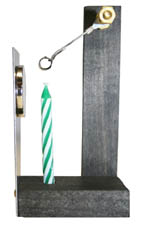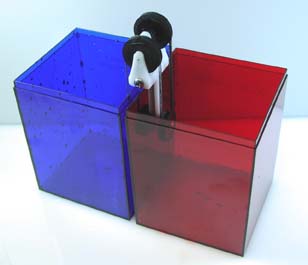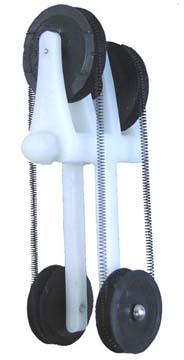Curie Point Magnetic Heat Engine – How it works

The heat engine uses a principle of magnetism discovered by Pierre Curie. He studied the effects of temperature on magnetism. Ferromagnetism covers the field of normal magnetism that people typically associate with magnets. All normal magnets and the materials that are attracted to magnets are ferromagnetic materials. Pierre Curie discovered that ferromagnetic materials have a critical temperature at which the material loses its ferromagnetic behavior. This is known as its Curie Point.
As an example, a piece of iron (Fe) at room temperature is strongly attracted to a magnet. Heat the iron to a temperature of 770 C, which is its Curie Point, it loses its ferromagnetism behavior and it is no longer attracted to a magnet. If we let the iron cool, it regains its ferromagnetic behavior and is attracted to the magnet again.
We can use this property to construct a small swinger type heat engine. The heat engine uses a nickel alloy wire that has a low Curie Point, see drawing to right. When the wire is at room temperature it is attracted to the magnet, and swings close to the magnet. In this position, labeled B in the drawing, it is heated by the flame of a small birthday cake candle. When the material temperature reaches its Curie Point, it loses it ferromagnetism and falls away from the magnet, to position A, and out of the candle flame. As the wire cools it regains its ferromagnetism and is attracted to the magnet again, where it swings back up toward the magnet to position B and back into the candle flame. This process repeats, swinging the nickel alloy wire back and forth.
Instruction and material supplies.
Pictures and videos of the heat engine functioning. Click on picture to view video.
Test Heat Engine Setup (.4 Meg) Running Heat Engine (1.5 meg)
Accessories
Components sold separately to build your own heat engine
DiscMagnet-01 - $7.95
1" diameter neodymium disc magnet
N-Wire-01 - $4.95
6" Low Curie Point Wire
Nitinol Heat Engine Kit

See
the Heat Engine in action!
More Information
Click on picture to see kit components
Nitinol Heat Engine -
powered by hot and cold water.
The Heat Engineis a very special kind of heat engine that demonstrates
the conversion of heat energy into mechanical energy. Based upon the
work of Dr. Alfred Johnson who was granted a patent on this type of heat engine in 1977 patent # 4,055,955.
It uses the unique property of Nitinol alloy to generate mechanical
motion from heat. Nitinol has trained into a shape at high temperature
(about 600° C) and allowed to cool to room temperature, where it can
be easily deformed and welded into a loop.
When heated above a transition temperature (in this application about
50° C to 70° C) the Nitinol object abruptly returns to its high-temperature
shape with a substantial force that is able to drive the pulleys and
thus create motion.


HE-02N - $65.95
Nitinol Heat Engine



